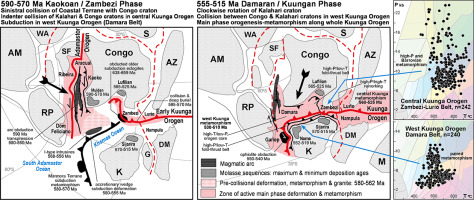当前位置:
X-MOL 学术
›
Gondwana Res.
›
论文详情
Our official English website, www.x-mol.net, welcomes your
feedback! (Note: you will need to create a separate account there.)
Assembly of central Gondwana along the Zambezi Belt: Metamorphic response and basement reactivation during the Kuunga Orogeny
Gondwana Research ( IF 7.2 ) Pub Date : 2020-04-01 , DOI: 10.1016/j.gr.2019.11.004 Ben Goscombe , David A. Foster , David Gray , Benjamin Wade
Gondwana Research ( IF 7.2 ) Pub Date : 2020-04-01 , DOI: 10.1016/j.gr.2019.11.004 Ben Goscombe , David A. Foster , David Gray , Benjamin Wade

|
Abstract Central Gondwana was assembled by three continental collisions in relatively quick succession: late Cryogenian East Africa Orogen, early Ediacaran West Antarctica Orogen and late Ediacaran Kuunga Orogen. The Kuunga Orogen involved diachronous closure of the South Adamastor–Khomas–Mozambique Oceans and accretion of Kalahari Craton and cratonic elements in Antarctica, with a previously assembled North Gondwana. The two older orogens were still hot and deforming at the time of final assembly by the Kuunga Orogen, and were therefore reworked and re-metamorphosed. The Central Kuunga Orogen is comprised of the Lufilian Arc, Zambezi Belt, Malawi–Unango Complex and the Lurio Belt. This region was the site of earliest collision in the Kuunga Orogen at ~575 Ma, and involved collision of two buoyant, previously metamorphosed rigid basement promontories. Pivoting on the Zambezi Belt indenters led to clockwise rotation of the Kalahari Craton and oblique collision within the Damara Belt ~20–30 m.y. later. The Central Kuunga Orogen is a relatively cold collisional belt dominated by eclogite, whiteschist and Barrovian series metamorphic parageneses, and contrasts with the paired metamorphic response in the Damara Belt to the west, and low-P/high-T metamorphism in the East Kuunga Orogen. Metamorphic parageneses are preserved from each stage of the full Wilson Cycle: from initiation of continental lithosphere thinning at ~940 Ma, widespread rifting between 725 and 805 Ma, and passive margin sedimentation until ~580 Ma. Eclogite-facies subduction parageneses indicate consumption of ocean lithosphere was underway by ~630–660 Ma. Collision at ~575 Ma involved deep burial of continental crust and formation of very high-P, low T/depth metamorphic parageneses, followed by Barrovian series thermal peaks at ~545 and ~525 Ma. Isostatic compensation and stress switches associated with plate reconfigurations once Gondwana was assembled, resulted in exhumation and local extension in an intra-continental setting from ~518 Ma.
中文翻译:

沿赞比西河带的冈瓦纳中部的集合:库恩加造山运动期间的变质反应和基底再激活
摘要 冈瓦纳中部由三个相对快速连续的大陆碰撞聚集而成:晚低温纪东非造山带、早埃迪卡拉纪西南极造山带和晚期埃迪卡拉纪库恩加造山带。Kuunga 造山带涉及南阿达马斯托尔-霍马斯-莫桑比克洋的历时闭合以及南极洲喀拉哈里克拉通和克拉通元素的增生,以及先前组装的北冈瓦纳。两座较老的造山带在库恩加造山带最后组装时仍处于高温和变形状态,因此被重新加工和重新变质。Central Kuunga Orogen 由 Lufilian Arc、Zambezi Belt、Malawi-Unango Complex 和 Lurio Belt 组成。该地区是约 575 Ma 的 Kuunga 造山带最早发生碰撞的地点,涉及两个有浮力的、以前变形的刚性地下室海角。在赞比西河带压头上的旋转导致 Kalahari Craton 顺时针旋转和 Damara 带内的斜向碰撞大约 20-30 年后。中央库恩加造山带是一条以榴辉岩、白片岩和巴罗维系变质共生岩为主的相对寒冷的碰撞带,与西部达马拉带的成对变质响应和东库恩加造山带的低P/高T变质作用形成对比. 整个威尔逊旋回的每个阶段都保留了变质共生期:从大陆岩石圈减薄开始到约 940 Ma,在 725 到 805 Ma 之间广泛裂谷,以及被动边缘沉积直到约 580 Ma。榴辉岩相俯冲共生表明大约 630-660 Ma 正在消耗海洋岩石圈。~575 Ma 的碰撞涉及大陆地壳的深埋和非常高 P、低 T/深度变质共生的形成,随后是 ~545 和 ~525 Ma 的 Barrovian 系列热峰。一旦冈瓦纳大陆被组装,与板块重构相关的等静压补偿和应力转换导致大陆内环境中从~518 Ma 开始剥落和局部扩展。
更新日期:2020-04-01
中文翻译:

沿赞比西河带的冈瓦纳中部的集合:库恩加造山运动期间的变质反应和基底再激活
摘要 冈瓦纳中部由三个相对快速连续的大陆碰撞聚集而成:晚低温纪东非造山带、早埃迪卡拉纪西南极造山带和晚期埃迪卡拉纪库恩加造山带。Kuunga 造山带涉及南阿达马斯托尔-霍马斯-莫桑比克洋的历时闭合以及南极洲喀拉哈里克拉通和克拉通元素的增生,以及先前组装的北冈瓦纳。两座较老的造山带在库恩加造山带最后组装时仍处于高温和变形状态,因此被重新加工和重新变质。Central Kuunga Orogen 由 Lufilian Arc、Zambezi Belt、Malawi-Unango Complex 和 Lurio Belt 组成。该地区是约 575 Ma 的 Kuunga 造山带最早发生碰撞的地点,涉及两个有浮力的、以前变形的刚性地下室海角。在赞比西河带压头上的旋转导致 Kalahari Craton 顺时针旋转和 Damara 带内的斜向碰撞大约 20-30 年后。中央库恩加造山带是一条以榴辉岩、白片岩和巴罗维系变质共生岩为主的相对寒冷的碰撞带,与西部达马拉带的成对变质响应和东库恩加造山带的低P/高T变质作用形成对比. 整个威尔逊旋回的每个阶段都保留了变质共生期:从大陆岩石圈减薄开始到约 940 Ma,在 725 到 805 Ma 之间广泛裂谷,以及被动边缘沉积直到约 580 Ma。榴辉岩相俯冲共生表明大约 630-660 Ma 正在消耗海洋岩石圈。~575 Ma 的碰撞涉及大陆地壳的深埋和非常高 P、低 T/深度变质共生的形成,随后是 ~545 和 ~525 Ma 的 Barrovian 系列热峰。一旦冈瓦纳大陆被组装,与板块重构相关的等静压补偿和应力转换导致大陆内环境中从~518 Ma 开始剥落和局部扩展。





















































 京公网安备 11010802027423号
京公网安备 11010802027423号